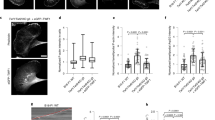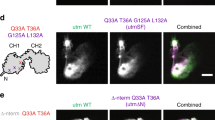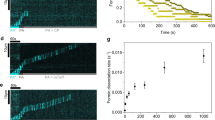Abstract
Regulated actin filament assembly is critical for eukaryotic cell physiology. Actin filaments are polar structures1, and those with free high affinity or barbed ends are crucial for actin dynamics and cell motility2. Actin filament barbed-end-capping proteins inhibit filament elongation after binding3, and their regulated disassociation is proposed to provide a source of free filament ends to drive processes dependent on actin polymerization4. To examine whether dissociation of actin filament capping proteins occurs with the correct spatio-temporal constraints to contribute to regulated actin assembly in live cells, I measured the dissociation of an actin capping protein, gelsolin, from actin in cells using a variation of fluorescence resonance energy transfer (FRET). Uncapping was found to occur in cells at sites of active actin assembly, including protruding lamellae and rocketing vesicles, with the correct spatio-temporal properties to provide sites of actin filament polymerization during protrusion. These observations are consistent with models where uncapping of existing filaments provides sites of actin filament elongation.
This is a preview of subscription content, access via your institution
Access options
Subscribe to this journal
Receive 12 print issues and online access
$209.00 per year
only $17.42 per issue
Buy this article
- Purchase on Springer Link
- Instant access to full article PDF
Prices may be subject to local taxes which are calculated during checkout





Similar content being viewed by others
References
Wegner, A. The mechanism of ATP hydrolysis by polymer actin. Biophys. Chem. 7, 51–58 (1977).
Toyama, S. A variant form of β-actin in a mutant of KB cells resistant to cytochalasin B. Cell 37, 609–614 (1984).
Cooper, J.A. & Schafer, D.A. Control of actin assembly and disassembly at filament ends. Curr. Opin. Cell Biol. 12, 97–103 (2000).
Stossel, T.P., Hartwig, J.H., Janmey, P.A. & Kwiatkowski, D.J. Cell crawling two decades after Abercrombie. Biochem. Soc. Symp. 65, 267–280 (1999).
Oosawa, F. & Asakura, S. Thermodynamics of the Polymerization of Protein (Acadmic Press, New York and London, 1975).
Symons, M.H. & Mitchison, T.J. Control of actin polymerization in live and permeabilized fibroblasts. J. Cell Biol. 114, 503–513 (1991).
Cassimeris, L., Safer, D., Nachmias, V.T. & Zigmond, S.H. Thymosin β4 sequesters the majority of G-actin in resting human polymorphonuclear leukocytes. J. Cell Biol. 119, 1261–1270 (1992).
Carlier, M.F. & Pantaloni, D. Control of actin dynamics in cell motility. J. Mol. Biol. 269, 459–467 (1997).
Pantaloni, D. & Carlier, M.F. How profilin promotes actin filament assembly in the presence of thymosin β4. Cell 75, 1007–1014 (1993).
Glogauer, M., Hartwig, J. & Stossel, T. Two pathways through Cdc42 couple the N-formyl receptor to actin nucleation in permeabilized human neutrophils. J. Cell Biol. 150, 785–796 (2000).
Hartwig, J.H. et al. Thrombin receptor ligation and activated Rac uncap actin filament barbed ends through phosphoinositide synthesis in permeabilized human platelets. Cell 82, 643–653 (1995).
Condeelis, J. How is actin polymerization nucleated in vivo? Trends Cell Biol. 11, 288–293 (2001).
Yin, H.L. & Stull, J.T. Proteins that regulate dynamic actin remodeling in response to membrane signaling minireview series. J. Biol. Chem. 274, 32529–32530 (1999).
Welch, M.D. The world according to Arp: regulation of actin nucleation by the Arp2/3 complex. Trends Cell Biol. 9, 423–427 (1999).
Sun, H.Q., Yamamoto, M., Mejillano, M. & Yin, H.L. Gelsolin, a multifunctional actin regulatory protein. J. Biol. Chem. 274, 33179–33182 (1999).
Selve, N. & Wegner, A. Rate constants and equilibrium constants for binding of the gelsolin–actin complex to the barbed ends of actin filaments in the presence and absence of calcium. Eur. J. Biochem. 160, 379–387 (1986).
Koepf, E.K. & Burtnick, L.D. Horse plasma gelsolin labelled with fluorescein isothiocyanate responds to calcium and actin. Eur. J. Biochem. 212, 713–718 (1993).
Kenworthy, A.K. Imaging protein–protein interactions using fluorescence resonance energy transfer microscopy. Methods 24, 289–296 (2001).
Rozelle, A.L. et al. Phosphatidylinositol 4,5-bisphosphate induces actin-based movement of raft-enriched vesicles through WASP-Arp2/3. Curr. Biol. 10, 311–320 (2000).
Suchy, S.F. & Nussbaum, R.L. The deficiency of PIP2 5-phosphatase in Lowe syndrome affects actin polymerization. Am. J. Hum. Genet. 71, 1420–1427 (2002).
Cooper, J.A. Effects of cytochalasin and phalloidin on actin. J. Cell Biol. 105, 1473–1478 (1987).
Kraynov, V.S. et al. Localized Rac activation dynamics visualized in living cells. Science 290, 333–337 (2000).
Varnai, P., Rother, K.I. & Balla, T. Phosphatidylinositol 3-kinase-dependent membrane association of the Bruton's tyrosine kinase pleckstrin homology domain visualized in single living cells. J. Biol. Chem. 274, 10983–10989 (1999).
Botelho, R.J. et al. Localized biphasic changes in phosphatidylinositol-4,5-bisphosphate at sites of phagocytosis. J. Cell Biol. 151, 1353–1368 (2000).
Oatey, P.B. et al. Confocal imaging of the subcellular distribution of phosphatidylinositol 3,4,5-trisphosphate in insulin- and PDGF-stimulated 3T3-L1 adipocytes. Biochem. J. 344, 511–518 (1999).
Carpenter, C.L., Tolias, K.F., Van Vugt, A. & Hartwig, J. Lipid kinases are novel effectors of the GTPase Rac1. Adv. Enzyme Regul. 39, 299–312 (1999).
Carpenter, C.L. Actin cytoskeleton and cell signaling. Crit. Care Med. 28, N94–N99 (2000).
Janmey, P.A., Xian, W. & Flanagan, L.A. Controlling cytoskeleton structure by phosphoinositide–protein interactions: phosphoinositide binding protein domains and effects of lipid packing. Chem. Phys. Lipids 101, 93–107 (1999).
Wang, Q. et al. Regulation of the formation of osteoclastic actin rings by proline-rich tyrosine kinase 2 interacting with gelsolin. J. Cell Biol. 160, 565–575 (2003).
Selve, N. & Wegner, A. Rate constants and equilibrium constants for binding of the gelsolin–actin complex to the barbed ends of actin filaments in the presence and absence of calcium. Eur. J. Biochem. 160, 379–387 (1986).
Bearer, E.L., Prakash, J.M., Manchester, R.D. & Allen, P.G. VASP protects actin filaments from gelsolin: an in vitro study with implications for platelet actin reorganizations. Cell Motil. Cytoskeleton 47, 351–364 (2000).
Rohatgi, R. et al. The interaction between N-WASP and the Arp2/3 complex links Cdc42- dependent signals to actin assembly. Cell 97, 221–231 (1999).
Blanchoin, L., Pollard, T.D. & Mullins, R.D. Interactions of ADF/cofilin, Arp2/3 complex, capping protein and profilin in remodeling of branched actin filament networks. Curr. Biol. 10, 1273–1282 (2000).
Falet, H. et al. Importance of free actin filament barbed ends for Arp2/3 complex function in platelets and fibroblasts. Proc. Natl Acad. Sci. USA 99, 16782–16787 (2002).
Pantaloni, D., Boujemaa, R., Didry, D., Gounon, P. & Carlier, M.F. The Arp2/3 complex branches filament barbed ends: functional antagonism with capping proteins. Nature Cell Biol. 2, 385–391 (2000).
Schafer, D.A. & Cooper, J.A. Control of actin assembly at filament ends. Annu. Rev. Cell Dev. Biol. 11, 497–518 (1995).
Taunton, J. et al. Actin-dependent propulsion of endosomes and lysosomes by recruitment of N-WASP. J. Cell Biol. 148, 519–530 (2000).
Ichetovkin, I., Grant, W. & Condeelis, J. Cofilin produces newly polymerized actin filaments that are preferred for dendritic nucleation by the Arp2/3 complex. Curr. Biol. 12, 79–84 (2002).
Lamb, J.A., Allen, P.G., Tuan, B.Y. & Janmey, P.A. Modulation of gelsolin function. Activation at low pH overrides Ca2+ requirement. J. Biol. Chem. 268, 8999–9004 (1993).
Allen, P.G. & Janmey, P.A. Gelsolin displaces phalloidin from actin filaments. A new fluorescence method shows that both Ca2+ and Mg2+ affect the rate at which gelsolin severs F-actin. J. Biol. Chem. 269, 32916–32923 (1994).
Palmgren, S., Ojala, P.J., Wear, M.A., Cooper, J.A. & Lappalainen, P. Interactions with PIP2, ADP–actin monomers, and capping protein regulate the activity and localization of yeast twinfilin. J. Cell Biol. 155, 251–260 (2001).
Azuma, T., Witke, W., Stossel, T.P., Hartwig, J.H. & Kwiatkowski, D.J. Gelsolin is a downstream effector of rac for fibroblast motility. EMBO J. 17, 1362–1370 (1998).
Acknowledgements
I would like to thank J. Hartwig, G. Cicchetti, M. Biernacki and J. Farquharson for critical reading of this manuscript. Initial samples of OCRL-deficient fibroblasts were provided by S. Suchy (National Institutes of Health). This work was supported by NIH grant RO1GM57256.
Author information
Authors and Affiliations
Ethics declarations
Competing interests
The author declares no competing financial interests.
Supplementary information
Supplementary Information, Fig. S1
Supplementary Information, Fig. S2 (PDF 1247 kb)
Supplementary Information, Fig. S3
Supplementary Information, Fig. S4
Rights and permissions
About this article
Cite this article
Allen, P. Actin filament uncapping localizes to ruffling lamellae and rocketing vesicles. Nat Cell Biol 5, 972–979 (2003). https://doi.org/10.1038/ncb1059
Published:
Issue Date:
DOI: https://doi.org/10.1038/ncb1059
This article is cited by
-
Isotherm kinetics of PIP2 bound gelsolin inactivation
Journal of Thermal Analysis and Calorimetry (2023)
-
The 5-phosphatase OCRL in Lowe syndrome and Dent disease 2
Nature Reviews Nephrology (2017)
-
Correlation between platelet gelsolin levels and different types of coronary heart disease
Chinese Science Bulletin (2012)
-
OCRL controls trafficking through early endosomes via PtdIns4,5P2-dependent regulation of endosomal actin
The EMBO Journal (2011)
-
Abi1 is essential for the formation and activation of a WAVE2 signalling complex
Nature Cell Biology (2004)



